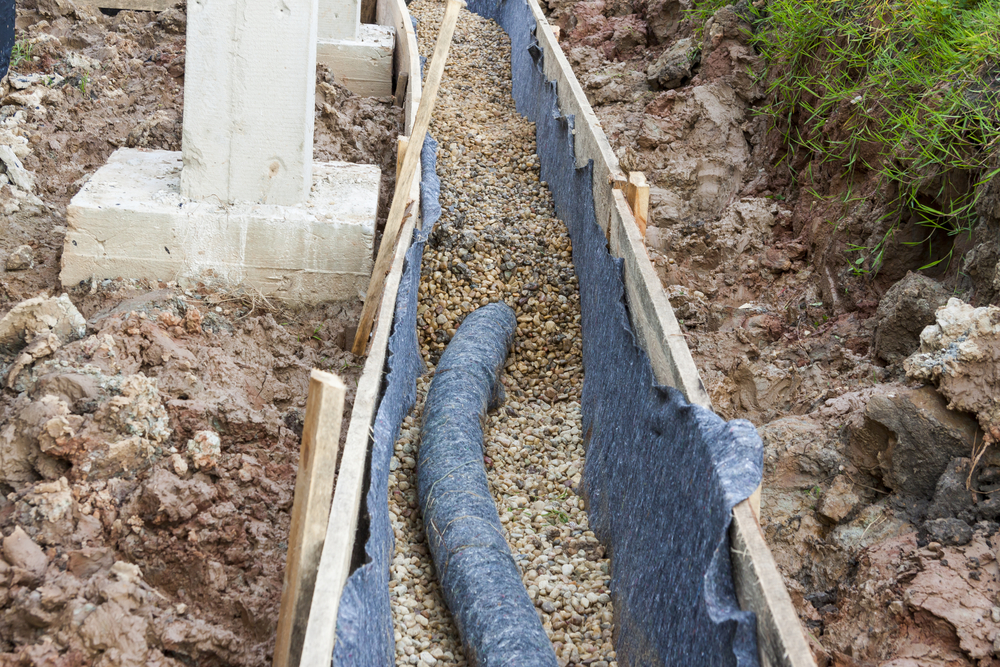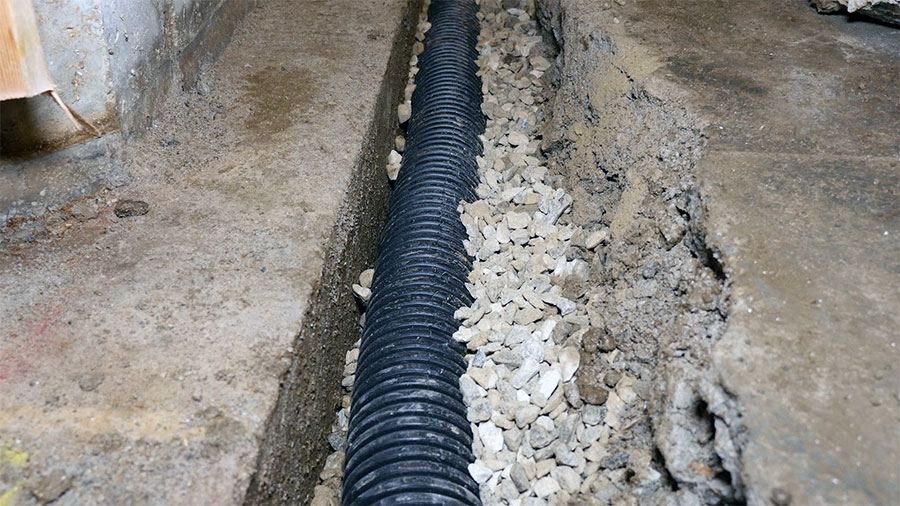The Essential Overview to Keeping Your French Drainpipe for Durable Efficiency
Maintaining your French drain is key to its efficiency and your residential property's security. Normal checks can save you from expensive repair work and water damages. You'll would like to know what indications to search for and exactly how frequently to examine your system. Plus, understanding the cleansing procedure can make a considerable difference. Allow's explore the important steps for guaranteeing your drain functions well for several years to come.
Understanding the Feature of a French Drain
A French drain is a crucial part in managing water around your home. It routes excess water far from your foundation, preventing flooding and damages. When heavy rain falls, the drainpipe accumulates water with a perforated pipeline buried in gravel. This system permits water to flow openly, minimizing stress on your basement wall surfaces and reducing the threat of leaks.You may wonder how it operates in method. As water saturates the dirt, gravity draws it toward the drain. The perforated pipe records this water, transporting it to an assigned water drainage location or storm sewage system. This procedure keeps your backyard dry and shields your home's architectural integrity.Understanding exactly how a French drainpipe features is key to valuing its value. By properly channeling water away, it assists maintain a completely dry and secure living setting. So, maintaining your French drain in leading condition assurances you avoid pricey repair work down the line.
Routine Inspections: What to Seek
When you're inspecting your French drainpipe, begin by inspecting for any kind of obstructions that could be blocking water circulation. Pay interest to indicators of surface area disintegration around the drainpipe, as this can indicate prospective issues. Routine evaluations will assist maintain your drain system functioning successfully.
Blocked Drainpipe Analysis
Exactly how can you inform if your French drain is clogged? Watch for water merging in your backyard, specifically after heavy rainfall. That's a red flag if you discover locations where water gathers rather of draining pipes. You ought to likewise inspect the drain electrical outlet; if water isn't flowing out as it should, there's likely an obstruction. Pay attention for uncommon gurgling noises, which can suggest trapped air. Additionally, check the drain's surface area for any type of vegetation development, as origins can clog the system and infiltrate. If you smell musty odors, it might direct to stationary water created by a clog. On a regular basis assessing these signs can help you keep your French drainpipe efficiently and stop expensive repairs.
Surface Erosion Examine

Cleaning Your French Drain: Step-by-Step Guide
Cleansing your French drainpipe is important for maintaining it functioning properly. You'll need some specific devices and a clear process to assure every little thing runs efficiently. Allow's stroll with the actions and ideas for preserving your drainpipe successfully.
Tools You'll Require
To deal with the task of cleaning your French drain effectively, you'll intend to gather a few crucial tools. Get hold of a tough set of gloves to safeguard your hands from particles and sharp items. A tiny shovel or trowel will help you eliminate dirt or clogs around the drainpipe. For removing the interior, a plumbing's snake or a high-pressure water nozzle can be exceptionally valuable. You'll also require a pail for collecting any kind of debris you take out. Having a yard pipe on hand will certainly make it less complicated to rinse out the drainpipe and assure it's streaming efficiently. With these tools prepared, you'll be set for a detailed cleaning session!
Cleansing Refine Actions
Begin by assessing the area around your French drain for any kind of visible debris or clogs. Eliminate fallen leaves, branches, or dirt that may obstruct water circulation. Next off, examine the inlet and outlet areas; clear any kind of blockages to guarantee appropriate water drainage. Utilize a garden hose pipe to flush the drainpipe, guiding water into the inlet. This helps dislodge any type of gathered sludge or debris. If you discover relentless obstructions, think about using a plumbing professional's snake to damage them up. After cleaning, check the gravel around the drainpipe; renew it if it's removed. Confirm the drainpipe covers are undamaged and firmly in area to stop debris from getting in. Routine cleaning maintains your French drainpipe working effectively.
Maintenance Regularity Tips
While routine upkeep is essential for your French drainpipe's longevity, understanding how frequently to preserve it can make all the distinction. Ideally, you must examine your French drain a minimum of twice a year, ideally in spring and autumn. After hefty rains or snowmelt, look for blockages or debris. If you discover any kind of standing water, it's time to clean your drain.In areas with hefty vegetation, even more frequent maintenance-- regarding every three months-- might be required. In addition, think about cleansing your French drainpipe after significant storms or see it here if you observe water pooling in your lawn. By staying positive, you'll ensure your French drain functions successfully and secures your home from water damage. Regular checks will conserve you money and time over time.
Determining Typical Issues and Their Solutions
When you notice water pooling in your yard or damp places in your cellar, it's essential to determine typical problems with your French drain and execute effective solutions. One constant trouble is blocking, typically brought on by particles like leaves or debris. To fix this, you can use a pipes serpent or a high-pressure water jet to clear blockages.Another problem may be incorrect incline. If your drain isn't sloped properly, water won't move away from your home. You can adjust the incline by excavating and rearranging the drain pipe.Lastly, look for damage or cracks in the drainpipe itself. Changing the harmed areas is crucial for peak efficiency if you find any. By addressing these problems promptly, you'll assist ensure that your French drainpipe continues to operate efficiently, protecting your residential property from water damages and maintaining a completely dry, safe setting.
Seasonal Maintenance Tips for Your French Drainpipe
Attending to common problems with your French drainpipe is just the initial action in ensuring its long-term efficiency. Seasonal upkeep is vital for peak efficiency. In the springtime, clear away leaves and particles that might have accumulated throughout winter. Look for any kind of obstructions in the electrical outlet or catch basin, as water needs a clear course to move freely.During summertime, evaluate your drain for any type of indicators of moving or resolving soil. Make sure it's still level and functioning properly. As loss approaches, clean out any type of dropped entrusts to prevent clogs before winter season arrives.In wintertime, expect freezing temperatures. Make sure your drain isn't at risk of cold if you live in a cold environment. Insulating exposed pipes can help. Routine checks and timely maintenance can avoid costly fixings and keep your French drain functioning properly year-round. Keep aggressive and appreciate peace of mind recognizing your drainage system remains in excellent form!
When to Call in an Expert
Recognizing when to call a specialist can conserve you time and stop additional damage to your French drainpipe. If you observe consistent standing water in your lawn, it's a clear sign that your drain might be obstructed or harmed. Don't overlook odd odors, as they can show sewage back-up or decay, which calls for instant attention.If you find that your drainpipe isn't operating effectively after attempts to tidy or preserve it, it's time to reach out for specialist assistance. Additionally, if you're unclear regarding the underlying issues or do not have the necessary devices, employing a specialist can offer tranquility of mind.Finally, if your French drain is old or has actually experienced considerable damage, expert assessment can figure out whether repair work or full replacement is required. Trust the experts to guarantee your drainage system functions efficiently for years to come.
Tips for Preventing Future Drain Troubles
To keep your French drainpipe operating efficiently, routinely examining and preserving it can make all the distinction. Start by removing particles, leaves, and dirt from the surface area and drain openings. This stops blockages that can result in water back-up. Examine the crushed rock around the drain; if it's compressed or deteriorated, consider adding fresh gravel to maintain optimal flow.Next, divert water far from your drainpipe by ensuring downspouts and rain gutters are clear and routing water a minimum of 3 feet away from your structure. Consistently inspect for any indications of damage or sagging. If you observe concerns, resolve them immediately.Finally, consider installing a filter or a catch basin to trap larger debris before it goes into the drain. By staying positive with these ideas, you'll lessen the threat of future water drainage troubles and maintain your French drainpipe in leading form.
Often Asked Questions
How much time Does a French Drain Usually Last?
A French drainpipe usually lasts around 30 to 40 years, depending on the materials utilized and upkeep (Portland French Drain). If you keep up with regular checks, you can extend its life expectancy even further
Can I Install a French Drainpipe Myself?
Yes, you can mount a French drainpipe yourself if you have actually obtained the right tools and knowledge. Just make sure to intend very carefully, adhere click for more to neighborhood laws, and assurance appropriate drainage to stay clear of future problems.
What Materials Are Utilized in a French Drain?
You'll need perforated pipeline, gravel, landscape fabric, and a strong drain pipe for your French drain. These products assist redirect water successfully, stopping flooding and keeping your residential property safe and completely dry from water damage.

Is a Permit Required to Install a French Drain?
You'll likely need an authorization to mount a French drainpipe, depending upon neighborhood regulations. Consult your district to assure you adhere to any type of needed guidelines and avoid prospective problems during setup.
What Are the Expenses Connected With French Drain Upkeep?
Keeping a French drainpipe typically sets you back in between $100 and $500 yearly. You'll need to think about expenditures for cleansing, fixings, and assessments. Routine maintenance aids Learn More Here stop larger expenditures and guarantees your system works properly for several years - Portland French Drain. When you're checking your French drain, beginning by inspecting for any obstructions that may be blocking water flow. By remaining positive, you'll assure your French drain features effectively and shields your residential or commercial property from water damages. When you observe water pooling in your backyard or damp spots in your cellar, it's important to recognize common concerns with your French drain and carry out reliable remedies. You can adjust the incline by digging and repositioning the drainpipe pipe.Lastly, check for damage or cracks in the drain itself. Inspect the crushed rock around the drain; if it's compressed or eroded, think about including fresh gravel to preserve perfect flow.Next, draw away water away from your drain by making sure seamless gutters and downspouts are clear and routing water at the very least three feet away from your structure